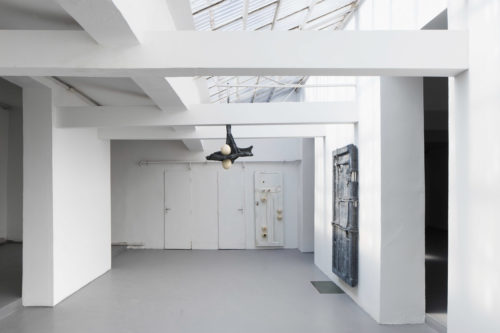3-inch Giant In Your Bathroom















At the turn of the 20th-century crystal was a great topic in art. Supposedly, it was due to its quality to symbolise the unity of the natural, organic and the ideal, geometric. In the same way, the work of Piotr Lakomy deals with a sort of inwardly self-determining order which, however, doesn’t operate in the classical, separated polarities, instead, it is somehow mutating, crossbred, it overflows, liquifies itself, gets satiated by this or that element, once geometric, another time organic. Even regarding the futuristic, cosmic, while at the same time eroded, trite, even wounded expression of his statues, it is, after all, impossible not to think of a sort of science-fiction appeal.
“Prickly constructions of indistinct shapes reached up to the height of a few floors. They had no windows, no doors, not even walls. Some looked like rippled, very densely knitted nets, cutting each other across in various directions and fortified in the spots of their connections, some resembled complicated spatial arabesques, similar to those arising when honeycombs penetrate themselves; or a net with triangular and pentagonal holes. In each larger element and in each visible surface it was possible to find some regularity, not as homogeneous as in a crystal, but indubitable, repeating itself in a certain rhythm, albeit in some places interrupted by marks of destruction. Some constructions were joined into a kind of cuboid-like shapes that were densely vegetated by branches (the branches didn’t grow geometrically, as it is with trees and bushes, though: they either generated a part of a bow or they were contorted into a spiral).
(…) It seemed to Rohan that they were some kind of cubiform and pyramidal rock shards, vegetated by dead, dried-up herbage. But even this impression was vanishing as he moved a few steps closer: at that moment a periodicity unknown to living forms appeared amidst the chaos of destruction.”
The Invincible, a book by Stanislaw Lem, deals in its storyline with the question of the evolution of dead matter, the evolution of machines, which the visitors of planet Regis III experience. Most of Lem’s books are about the impossibility of communication with another life form. Consequently, though, they are also about the impossibility to even imagine in detail such kind of radically different form.
Lakomy, too, is known for often using hexagonal faveolate aluminium constructions in his artwork, their shape is derived from honeycombs. Faveolates generally allow proportionally minimal use of material, resulting in minimal weight in relation to the high level of resistance against pressure and traction. This is also one of the reasons why the material is used in aeronautical cosmic research.
The statues of Piotr Lakomy in gallery FUTURA follow two basic scales: 1:1 and 1:10. The smaller one is never separated though, it’s always connected, welded on a larger statue it grows out of. The smaller scale statues are copies of other statues, some of them are also exhibited; they are in a smaller cast though, complemented by some kind of intervention, an addition, which always includes a human body print, especially of fingers and palms. Some of the statues are complemented by an ostrich egg, again a typical element Lakomy uses and which is again, on one hand, a kind of natural scale factor and on the other a sort of reality touch, another organic, yet at the same time a strongly sculptural, perfectly geometrical element.
The faveolate structure is always applied on some base or frame, which it then cases or perfoliate, adding a kind of life-like, organic dimension as well as the architectural one. That explains Lakomy’s favourite structures of doors and windows or some kind of tents or umbrellas. In the same way, as Lem writes:” They had no windows, no doors, not even walls,” they are at the same time architecture as well as body. The combination of surface, architecture and sculpture might thus be perceived just as a consistent self-projection, the reflection of ourselves, while at the same time possibly the reflection of a kind of essence, that order which transcends us.
© Michal Novotný